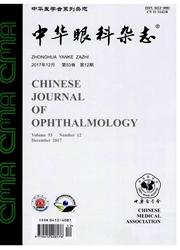

 中文摘要:
中文摘要:
目的探讨超抗原金黄色葡萄球菌肠毒素B(SEB)诱导大鼠高危角膜移植免疫耐受时CD4+CD25+调节性T细胞在眼局部及全身的表达情况。方法本实验采用对照设计,以13只SD大鼠作为供体,26只Wistar大鼠作为受体建立高危穿透性角膜移植模型。所有受体大鼠抽签法随机分为2组,对照组和SEB组分别腹腔注射生理盐水和SEB(75μg/kg体重),1次/4d,共3次,末次注射后1d行右眼穿透性角膜移植术。术后观察大鼠角膜植片的存活时间,并采用免疫荧光染色分析CD4+CD25+T细胞在大鼠角膜植片和虹膜的表达,使用流式细胞学方法分析外周血中的CD4+CD25+T细胞百分数。结果对照组大鼠角膜植片平均存活时间为(11.63±2.83)d,SEB组为(14.13±0.99)d,两组间比较差异有统计学意义(P〈0.05)。组织病理学检查可见发生排斥的角膜植片有大量炎性细胞浸润,炎性细胞数量与排斥反应程度呈正相关性。直接免疫荧光染色检查可见术前两组角膜组织均不表达CD4+CD25+T细胞,而术后20d两组均有表达。虹膜铺片直接免疫荧光染色检查术前对照组未见CD4+CD25+T细胞表达,而SEB组(首次注射SEB后第10天)虹膜片可见CD4+CD25+T细胞表达,术后第20天两组大鼠虹膜铺片均可见CD4+CD25+T细胞表达,并且SEB组阳性细胞数更多。流式细胞学方法分析显示手术前后、对照组大鼠外周血中CD4+CD25+T细胞的百分数无变化,而SEB组呈先升高、后降低的变化趋势。结论CD4+CD25+调节性T细胞参与超抗原SEB诱导大鼠高危角膜移植术后免疫耐受的形成。
 英文摘要:
英文摘要:
Objective To explore the expression of CD4 + CD25 + regulatory T cells in corneal graft, in the iris and peripheral blood in the high risk rat corneal transplant tolerance induced by superantigen staphylococcal enterotoxin B (SEB). Methods A high risk rat penetrating corneal transplantation model was established, whereas SD rat donor corneas were implanted into Wistar rat recipients. The recipient rats were divided into two groups. Group control and group SEB had intraperitoneal injection of normal saline solution or SEB (75 μg/kg), respectively. Orthotropic corneal transplantation was performed 1 day after the injection. The corneal graft survival time was evaluated. The expression of CD4 + CD25 + T cells in corneal grafts and the iris was evaluated by immunohistochemical staining. The percentage of CD4 + CD25 + regulatory T cells in peripheral blood was determined by flow cytometry. Results Corneal graft mean survival time was ( 11. 63 ± 2. 83 ) d in group control and (14.13 ± 0. 99 ) din group SEB. The difference of survival time between these two groups was statistically significant( P 〈 0. 05 ). Histopathology showed remarkable inflammatory cells infiltration in the rejected grafts. The intensity of the infiltration was compatible with the severity of rejection reaction. Immunohistochemical staining of grafts showed that the CD4 + CD25 + regulatory T cells were expressed in rejected grafts in both groups 20 days after the surgery, but not before the surgery. The iris whole mount staining showed that before the surgery, no expression of CD4 + CD25 + regulatory T cells was observed in group control but relatively remarkable expression was observed in group SEB. Twenty days after the transplantation, CD4 + CD25 + regulatory T cells were observed in both groups while group SEB had more pronounced expression. Peripheral blood flow cytometry analysis revealed that the mean percentages of CD4 + CD25 + regulatory T cells were stable before and after surgery in gro
 同期刊论文项目
同期刊论文项目
 同项目期刊论文
同项目期刊论文
 期刊信息
期刊信息
